Organisational and Human Resource Functioning Report
VerifiedAdded on 2020/04/15
|8
|1749
|33
Report
AI Summary
This report provides a comprehensive analysis of human resource management (HRM) within an organisational context. It begins by exploring the concept of organisational structure, differentiating between tall and flat structures, and then applies this to a case study, Consult Land, which is determined to have a tall structure due to its size and global presence. The report also examines corporate culture, discussing Charles Handy's four culture types: power, role, task, and person culture. It then delves into leadership styles, highlighting the democratic style adopted by Consult Land, and discusses the importance of employee participation in decision-making. The report further examines HRM functions, focusing on reward management and training and development as key strategies for employee retention and organizational growth. The conclusion stresses the importance of an appropriate organisational structure, a supportive corporate culture, and effective HRM practices, including reward systems and training programs, to ensure employee satisfaction and organizational success. The report uses references to support the arguments made.
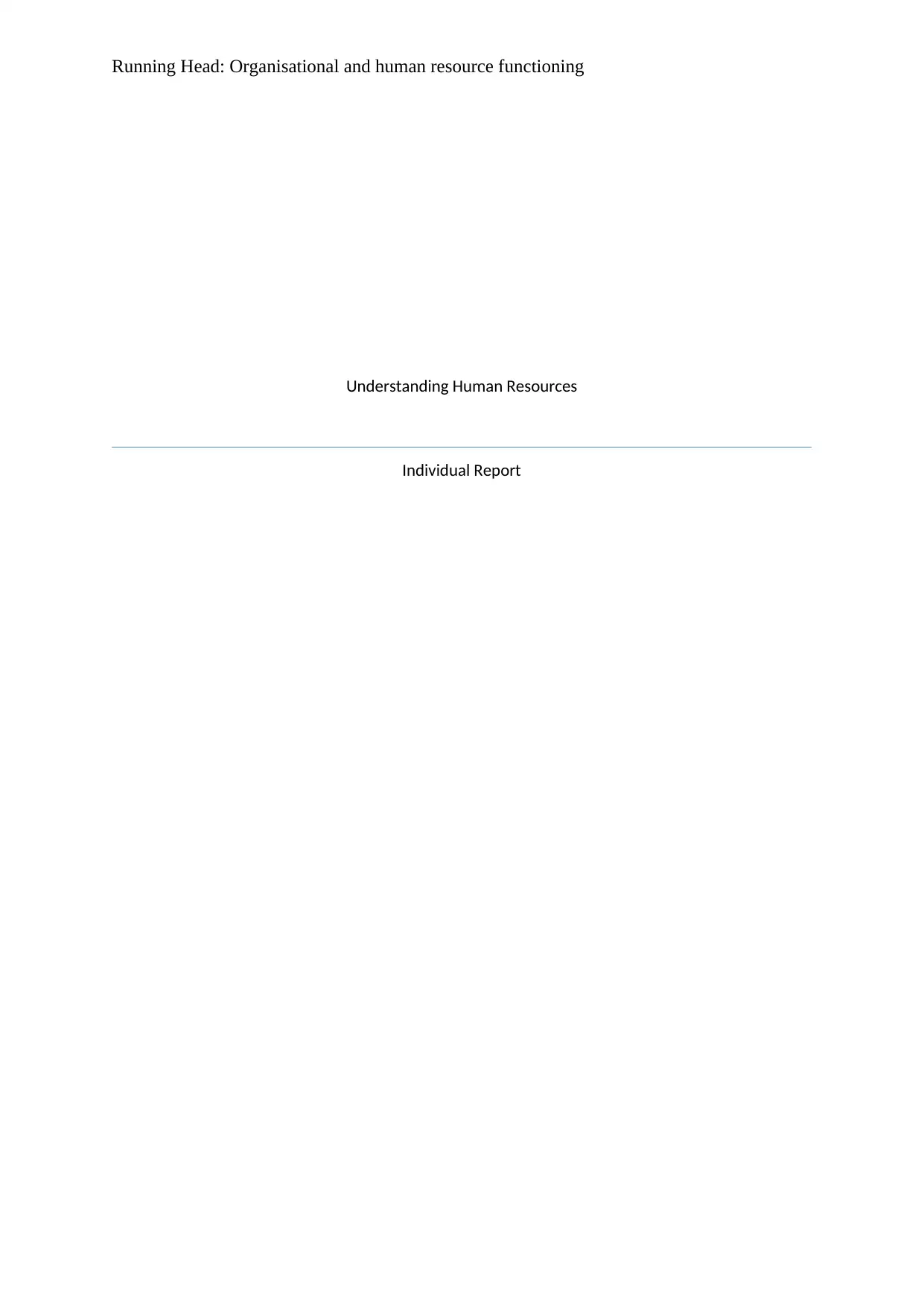
Running Head: Organisational and human resource functioning
Understanding Human Resources
Individual Report
Understanding Human Resources
Individual Report
Paraphrase This Document
Need a fresh take? Get an instant paraphrase of this document with our AI Paraphraser
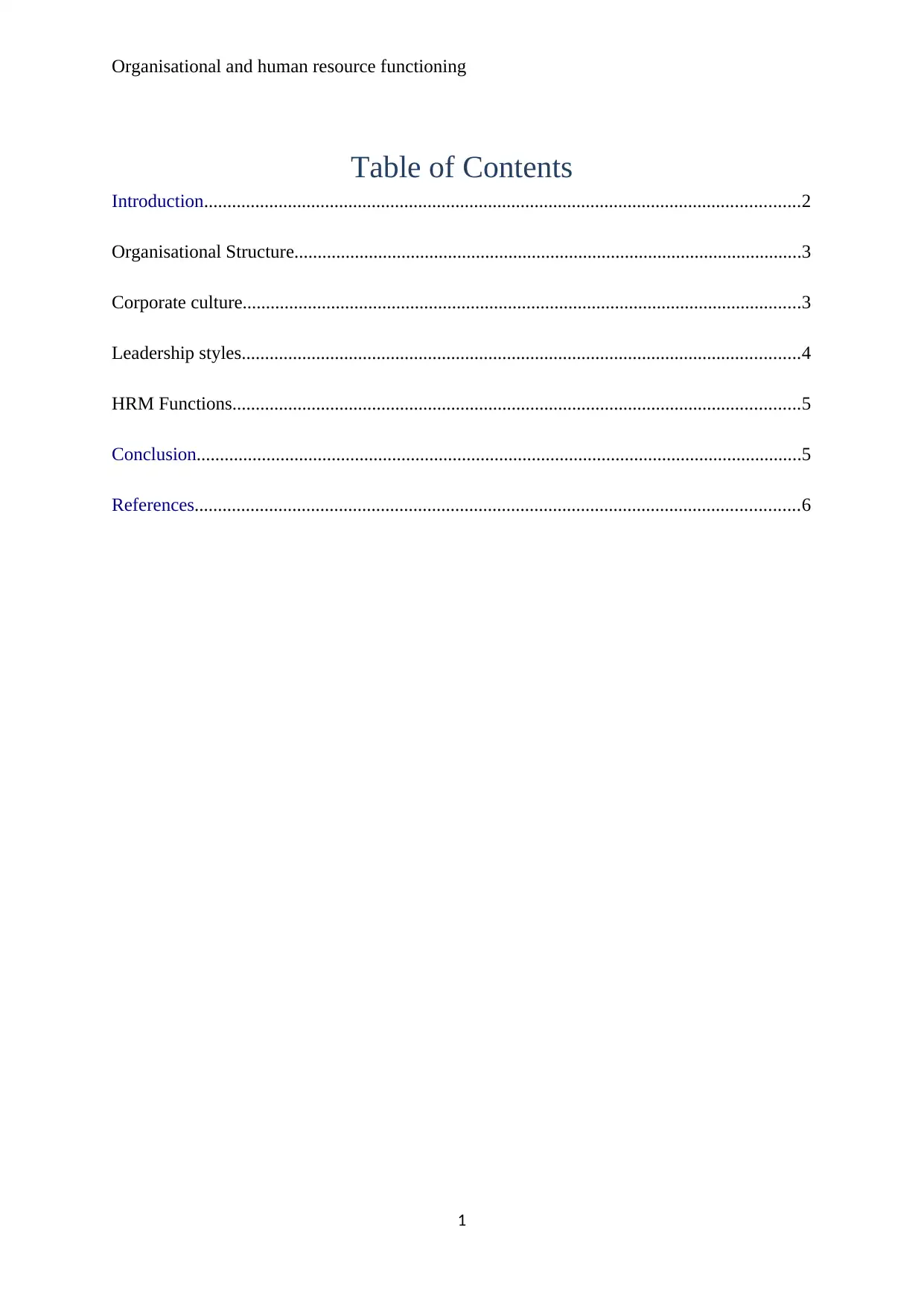
Organisational and human resource functioning
Table of Contents
Introduction................................................................................................................................2
Organisational Structure.............................................................................................................3
Corporate culture........................................................................................................................3
Leadership styles........................................................................................................................4
HRM Functions..........................................................................................................................5
Conclusion..................................................................................................................................5
References..................................................................................................................................6
1
Table of Contents
Introduction................................................................................................................................2
Organisational Structure.............................................................................................................3
Corporate culture........................................................................................................................3
Leadership styles........................................................................................................................4
HRM Functions..........................................................................................................................5
Conclusion..................................................................................................................................5
References..................................................................................................................................6
1
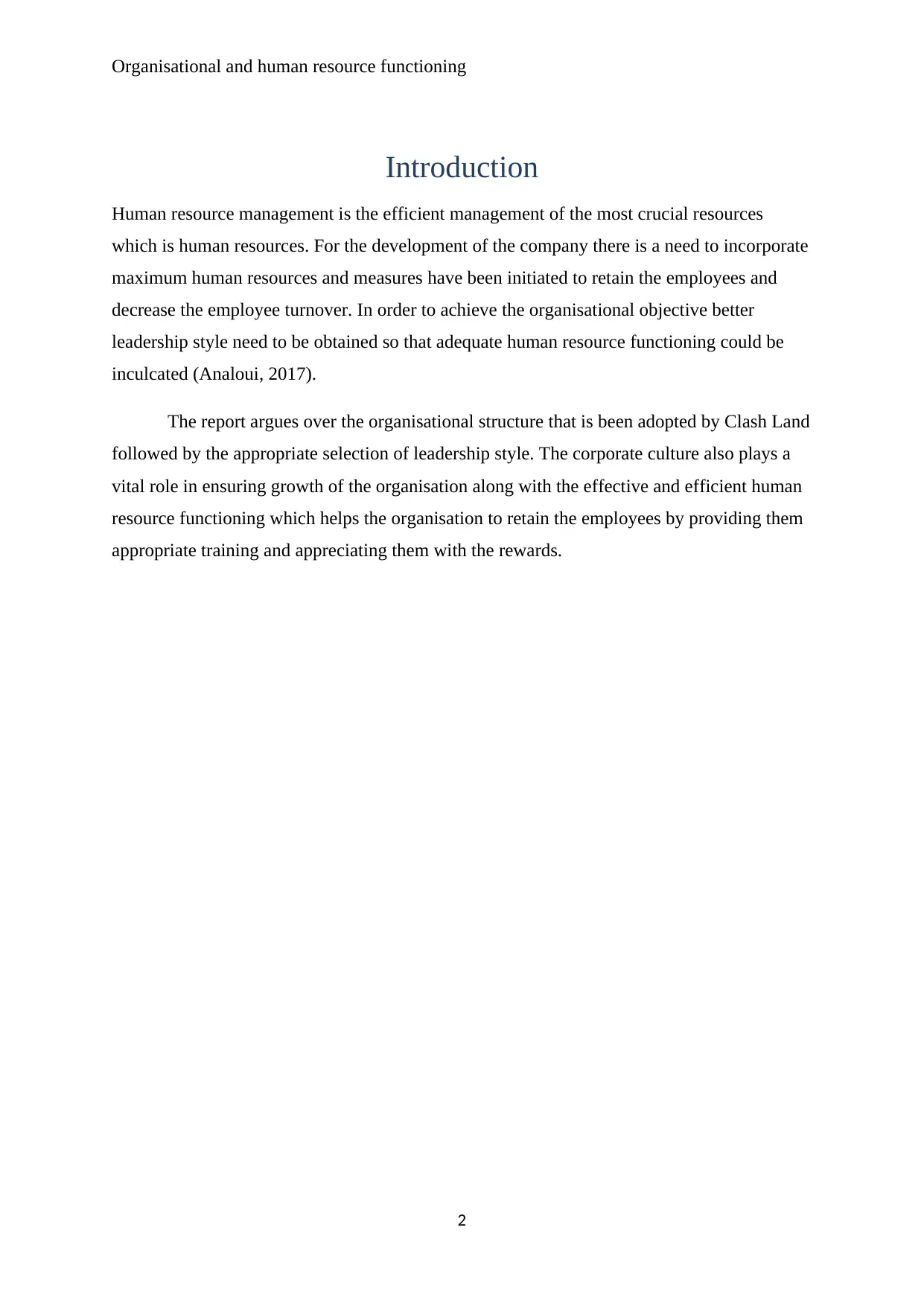
Organisational and human resource functioning
Introduction
Human resource management is the efficient management of the most crucial resources
which is human resources. For the development of the company there is a need to incorporate
maximum human resources and measures have been initiated to retain the employees and
decrease the employee turnover. In order to achieve the organisational objective better
leadership style need to be obtained so that adequate human resource functioning could be
inculcated (Analoui, 2017).
The report argues over the organisational structure that is been adopted by Clash Land
followed by the appropriate selection of leadership style. The corporate culture also plays a
vital role in ensuring growth of the organisation along with the effective and efficient human
resource functioning which helps the organisation to retain the employees by providing them
appropriate training and appreciating them with the rewards.
2
Introduction
Human resource management is the efficient management of the most crucial resources
which is human resources. For the development of the company there is a need to incorporate
maximum human resources and measures have been initiated to retain the employees and
decrease the employee turnover. In order to achieve the organisational objective better
leadership style need to be obtained so that adequate human resource functioning could be
inculcated (Analoui, 2017).
The report argues over the organisational structure that is been adopted by Clash Land
followed by the appropriate selection of leadership style. The corporate culture also plays a
vital role in ensuring growth of the organisation along with the effective and efficient human
resource functioning which helps the organisation to retain the employees by providing them
appropriate training and appreciating them with the rewards.
2
⊘ This is a preview!⊘
Do you want full access?
Subscribe today to unlock all pages.

Trusted by 1+ million students worldwide
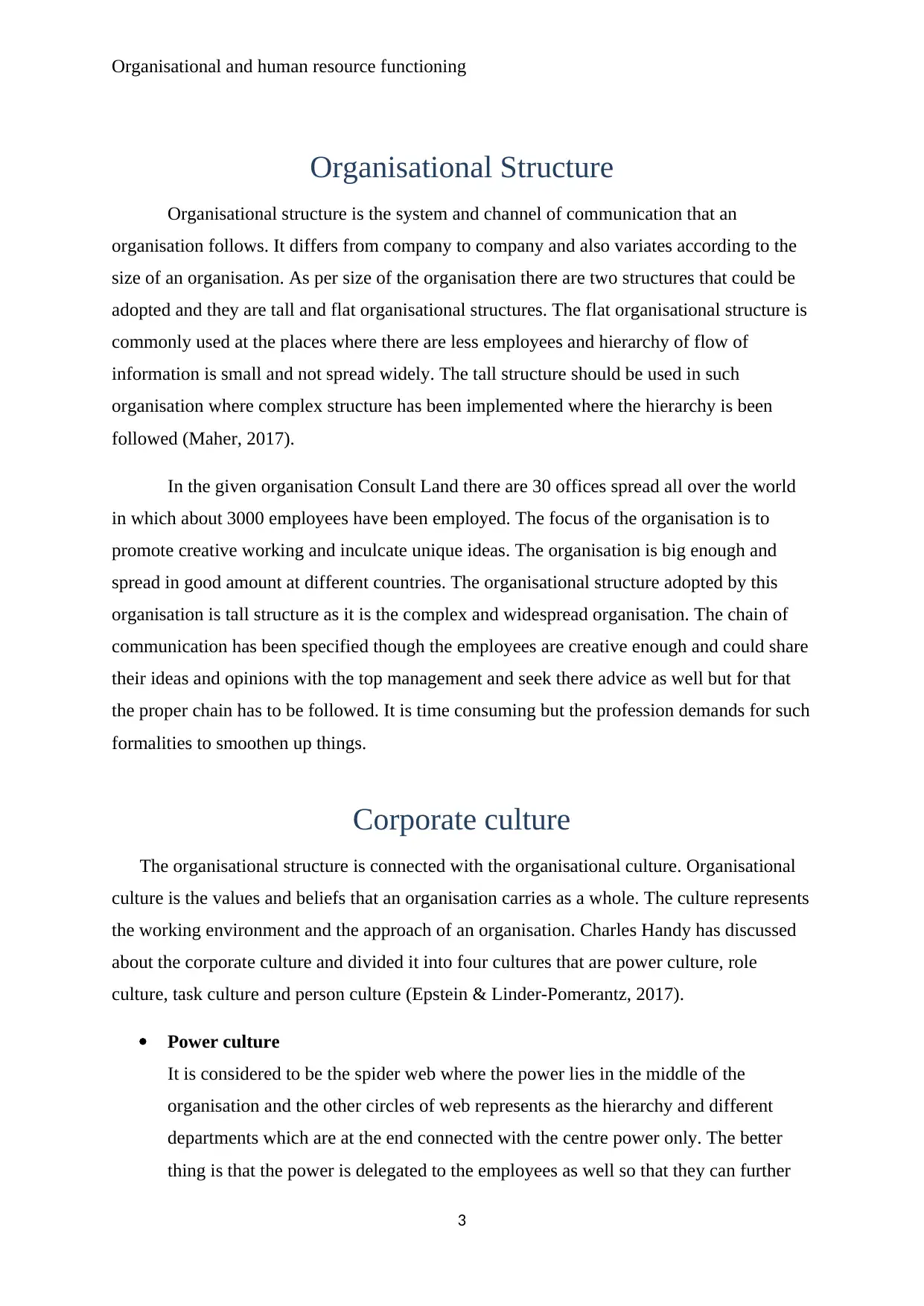
Organisational and human resource functioning
Organisational Structure
Organisational structure is the system and channel of communication that an
organisation follows. It differs from company to company and also variates according to the
size of an organisation. As per size of the organisation there are two structures that could be
adopted and they are tall and flat organisational structures. The flat organisational structure is
commonly used at the places where there are less employees and hierarchy of flow of
information is small and not spread widely. The tall structure should be used in such
organisation where complex structure has been implemented where the hierarchy is been
followed (Maher, 2017).
In the given organisation Consult Land there are 30 offices spread all over the world
in which about 3000 employees have been employed. The focus of the organisation is to
promote creative working and inculcate unique ideas. The organisation is big enough and
spread in good amount at different countries. The organisational structure adopted by this
organisation is tall structure as it is the complex and widespread organisation. The chain of
communication has been specified though the employees are creative enough and could share
their ideas and opinions with the top management and seek there advice as well but for that
the proper chain has to be followed. It is time consuming but the profession demands for such
formalities to smoothen up things.
Corporate culture
The organisational structure is connected with the organisational culture. Organisational
culture is the values and beliefs that an organisation carries as a whole. The culture represents
the working environment and the approach of an organisation. Charles Handy has discussed
about the corporate culture and divided it into four cultures that are power culture, role
culture, task culture and person culture (Epstein & Linder-Pomerantz, 2017).
Power culture
It is considered to be the spider web where the power lies in the middle of the
organisation and the other circles of web represents as the hierarchy and different
departments which are at the end connected with the centre power only. The better
thing is that the power is delegated to the employees as well so that they can further
3
Organisational Structure
Organisational structure is the system and channel of communication that an
organisation follows. It differs from company to company and also variates according to the
size of an organisation. As per size of the organisation there are two structures that could be
adopted and they are tall and flat organisational structures. The flat organisational structure is
commonly used at the places where there are less employees and hierarchy of flow of
information is small and not spread widely. The tall structure should be used in such
organisation where complex structure has been implemented where the hierarchy is been
followed (Maher, 2017).
In the given organisation Consult Land there are 30 offices spread all over the world
in which about 3000 employees have been employed. The focus of the organisation is to
promote creative working and inculcate unique ideas. The organisation is big enough and
spread in good amount at different countries. The organisational structure adopted by this
organisation is tall structure as it is the complex and widespread organisation. The chain of
communication has been specified though the employees are creative enough and could share
their ideas and opinions with the top management and seek there advice as well but for that
the proper chain has to be followed. It is time consuming but the profession demands for such
formalities to smoothen up things.
Corporate culture
The organisational structure is connected with the organisational culture. Organisational
culture is the values and beliefs that an organisation carries as a whole. The culture represents
the working environment and the approach of an organisation. Charles Handy has discussed
about the corporate culture and divided it into four cultures that are power culture, role
culture, task culture and person culture (Epstein & Linder-Pomerantz, 2017).
Power culture
It is considered to be the spider web where the power lies in the middle of the
organisation and the other circles of web represents as the hierarchy and different
departments which are at the end connected with the centre power only. The better
thing is that the power is delegated to the employees as well so that they can further
3
Paraphrase This Document
Need a fresh take? Get an instant paraphrase of this document with our AI Paraphraser
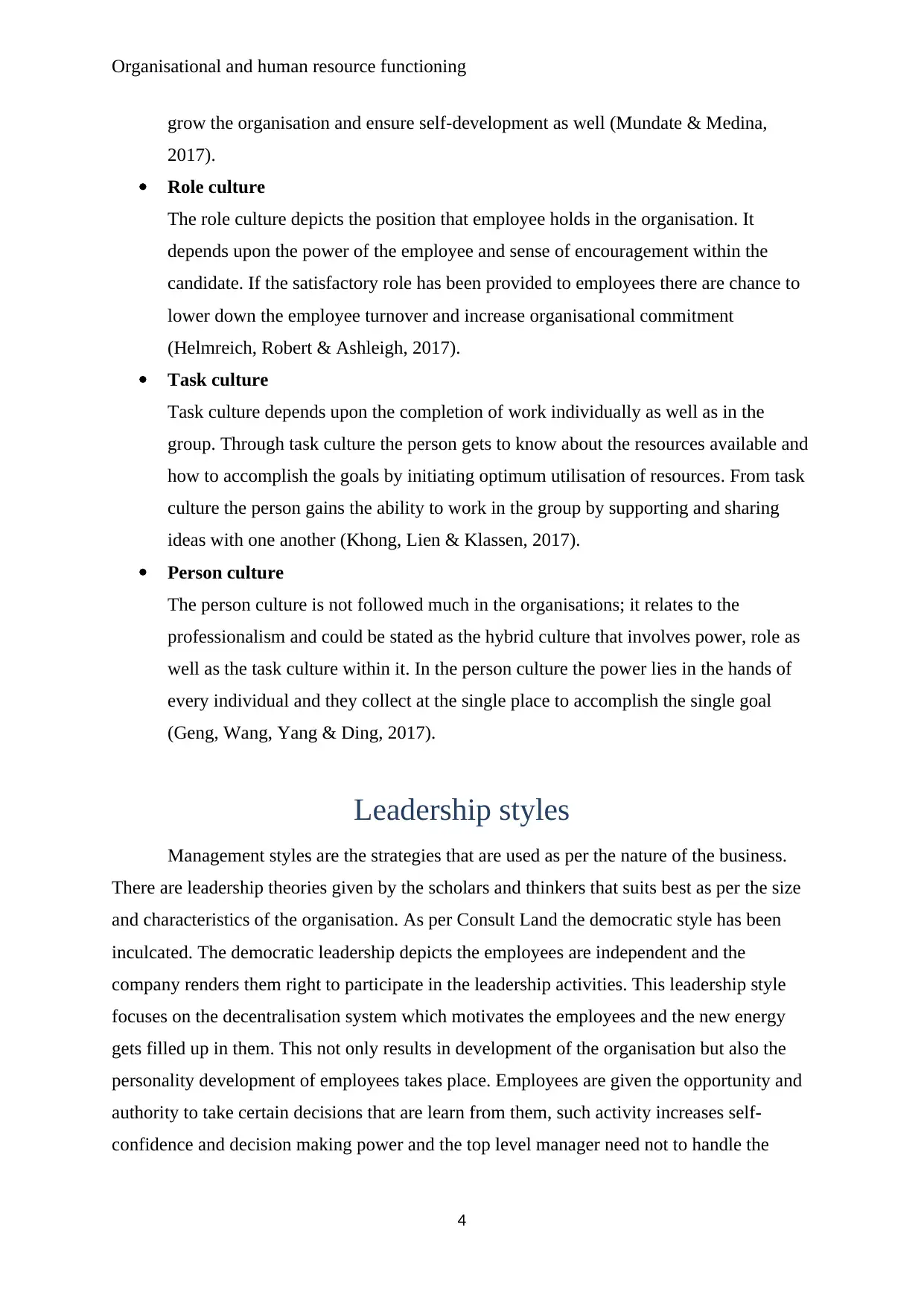
Organisational and human resource functioning
grow the organisation and ensure self-development as well (Mundate & Medina,
2017).
Role culture
The role culture depicts the position that employee holds in the organisation. It
depends upon the power of the employee and sense of encouragement within the
candidate. If the satisfactory role has been provided to employees there are chance to
lower down the employee turnover and increase organisational commitment
(Helmreich, Robert & Ashleigh, 2017).
Task culture
Task culture depends upon the completion of work individually as well as in the
group. Through task culture the person gets to know about the resources available and
how to accomplish the goals by initiating optimum utilisation of resources. From task
culture the person gains the ability to work in the group by supporting and sharing
ideas with one another (Khong, Lien & Klassen, 2017).
Person culture
The person culture is not followed much in the organisations; it relates to the
professionalism and could be stated as the hybrid culture that involves power, role as
well as the task culture within it. In the person culture the power lies in the hands of
every individual and they collect at the single place to accomplish the single goal
(Geng, Wang, Yang & Ding, 2017).
Leadership styles
Management styles are the strategies that are used as per the nature of the business.
There are leadership theories given by the scholars and thinkers that suits best as per the size
and characteristics of the organisation. As per Consult Land the democratic style has been
inculcated. The democratic leadership depicts the employees are independent and the
company renders them right to participate in the leadership activities. This leadership style
focuses on the decentralisation system which motivates the employees and the new energy
gets filled up in them. This not only results in development of the organisation but also the
personality development of employees takes place. Employees are given the opportunity and
authority to take certain decisions that are learn from them, such activity increases self-
confidence and decision making power and the top level manager need not to handle the
4
grow the organisation and ensure self-development as well (Mundate & Medina,
2017).
Role culture
The role culture depicts the position that employee holds in the organisation. It
depends upon the power of the employee and sense of encouragement within the
candidate. If the satisfactory role has been provided to employees there are chance to
lower down the employee turnover and increase organisational commitment
(Helmreich, Robert & Ashleigh, 2017).
Task culture
Task culture depends upon the completion of work individually as well as in the
group. Through task culture the person gets to know about the resources available and
how to accomplish the goals by initiating optimum utilisation of resources. From task
culture the person gains the ability to work in the group by supporting and sharing
ideas with one another (Khong, Lien & Klassen, 2017).
Person culture
The person culture is not followed much in the organisations; it relates to the
professionalism and could be stated as the hybrid culture that involves power, role as
well as the task culture within it. In the person culture the power lies in the hands of
every individual and they collect at the single place to accomplish the single goal
(Geng, Wang, Yang & Ding, 2017).
Leadership styles
Management styles are the strategies that are used as per the nature of the business.
There are leadership theories given by the scholars and thinkers that suits best as per the size
and characteristics of the organisation. As per Consult Land the democratic style has been
inculcated. The democratic leadership depicts the employees are independent and the
company renders them right to participate in the leadership activities. This leadership style
focuses on the decentralisation system which motivates the employees and the new energy
gets filled up in them. This not only results in development of the organisation but also the
personality development of employees takes place. Employees are given the opportunity and
authority to take certain decisions that are learn from them, such activity increases self-
confidence and decision making power and the top level manager need not to handle the
4
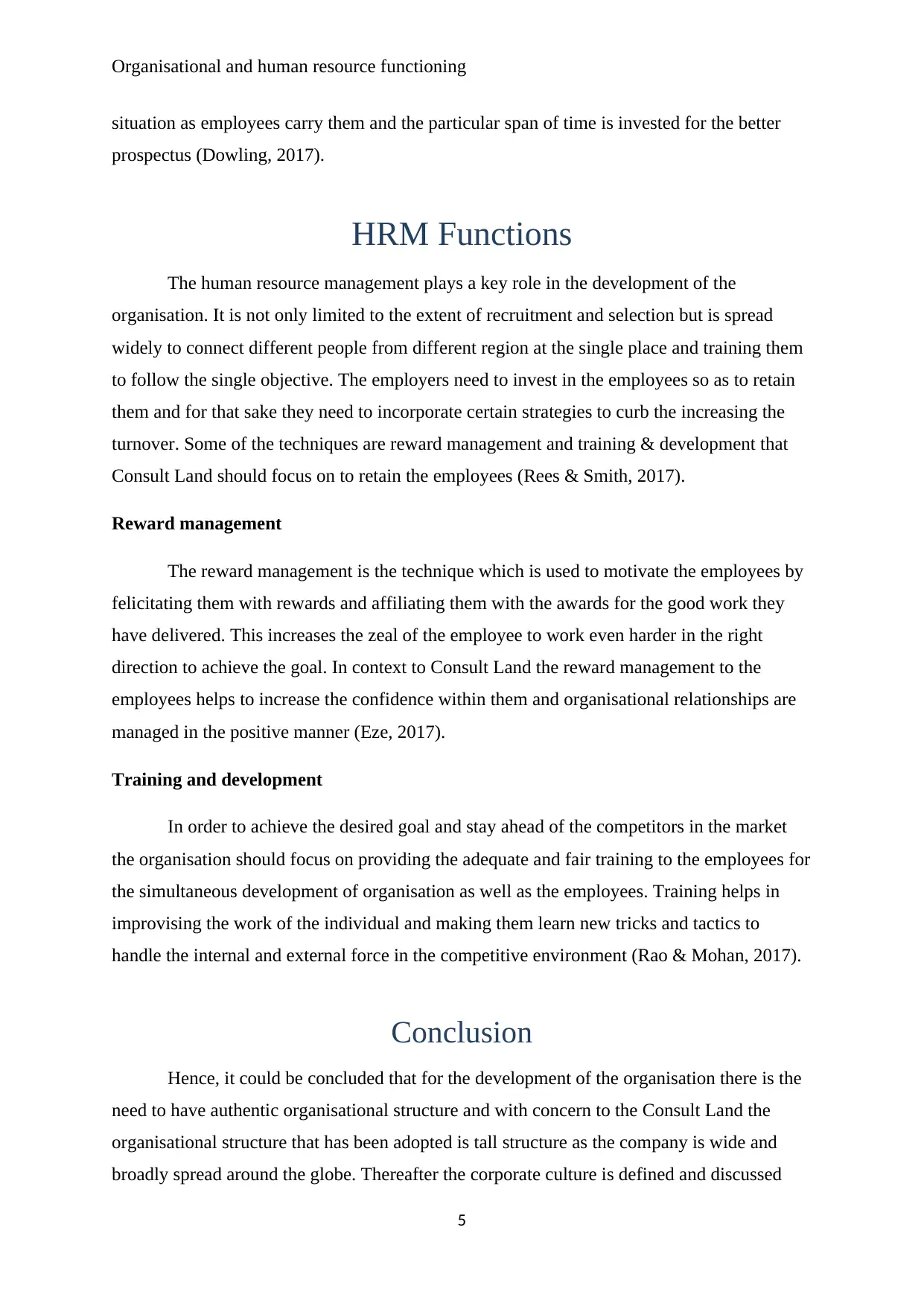
Organisational and human resource functioning
situation as employees carry them and the particular span of time is invested for the better
prospectus (Dowling, 2017).
HRM Functions
The human resource management plays a key role in the development of the
organisation. It is not only limited to the extent of recruitment and selection but is spread
widely to connect different people from different region at the single place and training them
to follow the single objective. The employers need to invest in the employees so as to retain
them and for that sake they need to incorporate certain strategies to curb the increasing the
turnover. Some of the techniques are reward management and training & development that
Consult Land should focus on to retain the employees (Rees & Smith, 2017).
Reward management
The reward management is the technique which is used to motivate the employees by
felicitating them with rewards and affiliating them with the awards for the good work they
have delivered. This increases the zeal of the employee to work even harder in the right
direction to achieve the goal. In context to Consult Land the reward management to the
employees helps to increase the confidence within them and organisational relationships are
managed in the positive manner (Eze, 2017).
Training and development
In order to achieve the desired goal and stay ahead of the competitors in the market
the organisation should focus on providing the adequate and fair training to the employees for
the simultaneous development of organisation as well as the employees. Training helps in
improvising the work of the individual and making them learn new tricks and tactics to
handle the internal and external force in the competitive environment (Rao & Mohan, 2017).
Conclusion
Hence, it could be concluded that for the development of the organisation there is the
need to have authentic organisational structure and with concern to the Consult Land the
organisational structure that has been adopted is tall structure as the company is wide and
broadly spread around the globe. Thereafter the corporate culture is defined and discussed
5
situation as employees carry them and the particular span of time is invested for the better
prospectus (Dowling, 2017).
HRM Functions
The human resource management plays a key role in the development of the
organisation. It is not only limited to the extent of recruitment and selection but is spread
widely to connect different people from different region at the single place and training them
to follow the single objective. The employers need to invest in the employees so as to retain
them and for that sake they need to incorporate certain strategies to curb the increasing the
turnover. Some of the techniques are reward management and training & development that
Consult Land should focus on to retain the employees (Rees & Smith, 2017).
Reward management
The reward management is the technique which is used to motivate the employees by
felicitating them with rewards and affiliating them with the awards for the good work they
have delivered. This increases the zeal of the employee to work even harder in the right
direction to achieve the goal. In context to Consult Land the reward management to the
employees helps to increase the confidence within them and organisational relationships are
managed in the positive manner (Eze, 2017).
Training and development
In order to achieve the desired goal and stay ahead of the competitors in the market
the organisation should focus on providing the adequate and fair training to the employees for
the simultaneous development of organisation as well as the employees. Training helps in
improvising the work of the individual and making them learn new tricks and tactics to
handle the internal and external force in the competitive environment (Rao & Mohan, 2017).
Conclusion
Hence, it could be concluded that for the development of the organisation there is the
need to have authentic organisational structure and with concern to the Consult Land the
organisational structure that has been adopted is tall structure as the company is wide and
broadly spread around the globe. Thereafter the corporate culture is defined and discussed
5
⊘ This is a preview!⊘
Do you want full access?
Subscribe today to unlock all pages.

Trusted by 1+ million students worldwide
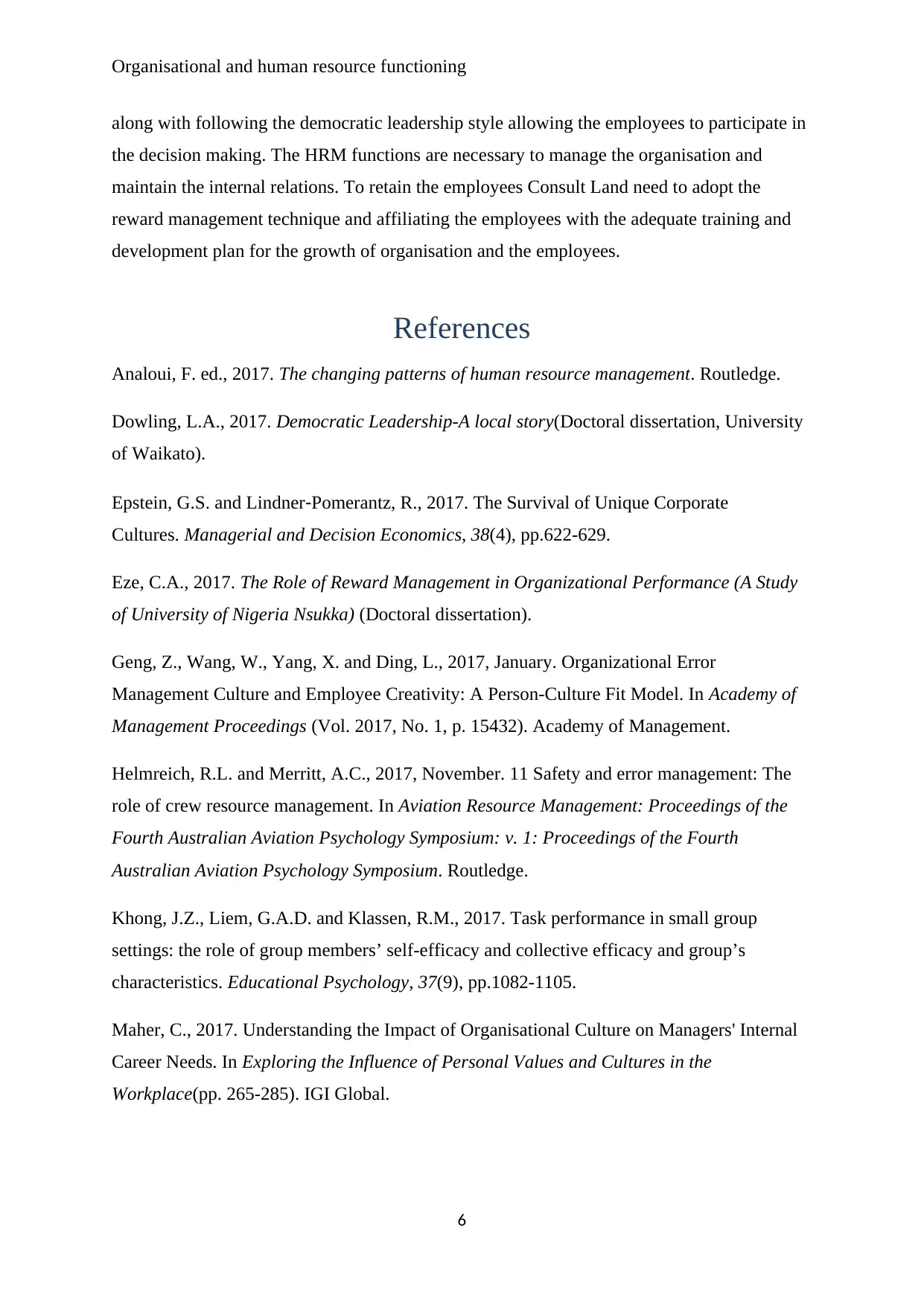
Organisational and human resource functioning
along with following the democratic leadership style allowing the employees to participate in
the decision making. The HRM functions are necessary to manage the organisation and
maintain the internal relations. To retain the employees Consult Land need to adopt the
reward management technique and affiliating the employees with the adequate training and
development plan for the growth of organisation and the employees.
References
Analoui, F. ed., 2017. The changing patterns of human resource management. Routledge.
Dowling, L.A., 2017. Democratic Leadership-A local story(Doctoral dissertation, University
of Waikato).
Epstein, G.S. and Lindner‐Pomerantz, R., 2017. The Survival of Unique Corporate
Cultures. Managerial and Decision Economics, 38(4), pp.622-629.
Eze, C.A., 2017. The Role of Reward Management in Organizational Performance (A Study
of University of Nigeria Nsukka) (Doctoral dissertation).
Geng, Z., Wang, W., Yang, X. and Ding, L., 2017, January. Organizational Error
Management Culture and Employee Creativity: A Person-Culture Fit Model. In Academy of
Management Proceedings (Vol. 2017, No. 1, p. 15432). Academy of Management.
Helmreich, R.L. and Merritt, A.C., 2017, November. 11 Safety and error management: The
role of crew resource management. In Aviation Resource Management: Proceedings of the
Fourth Australian Aviation Psychology Symposium: v. 1: Proceedings of the Fourth
Australian Aviation Psychology Symposium. Routledge.
Khong, J.Z., Liem, G.A.D. and Klassen, R.M., 2017. Task performance in small group
settings: the role of group members’ self-efficacy and collective efficacy and group’s
characteristics. Educational Psychology, 37(9), pp.1082-1105.
Maher, C., 2017. Understanding the Impact of Organisational Culture on Managers' Internal
Career Needs. In Exploring the Influence of Personal Values and Cultures in the
Workplace(pp. 265-285). IGI Global.
6
along with following the democratic leadership style allowing the employees to participate in
the decision making. The HRM functions are necessary to manage the organisation and
maintain the internal relations. To retain the employees Consult Land need to adopt the
reward management technique and affiliating the employees with the adequate training and
development plan for the growth of organisation and the employees.
References
Analoui, F. ed., 2017. The changing patterns of human resource management. Routledge.
Dowling, L.A., 2017. Democratic Leadership-A local story(Doctoral dissertation, University
of Waikato).
Epstein, G.S. and Lindner‐Pomerantz, R., 2017. The Survival of Unique Corporate
Cultures. Managerial and Decision Economics, 38(4), pp.622-629.
Eze, C.A., 2017. The Role of Reward Management in Organizational Performance (A Study
of University of Nigeria Nsukka) (Doctoral dissertation).
Geng, Z., Wang, W., Yang, X. and Ding, L., 2017, January. Organizational Error
Management Culture and Employee Creativity: A Person-Culture Fit Model. In Academy of
Management Proceedings (Vol. 2017, No. 1, p. 15432). Academy of Management.
Helmreich, R.L. and Merritt, A.C., 2017, November. 11 Safety and error management: The
role of crew resource management. In Aviation Resource Management: Proceedings of the
Fourth Australian Aviation Psychology Symposium: v. 1: Proceedings of the Fourth
Australian Aviation Psychology Symposium. Routledge.
Khong, J.Z., Liem, G.A.D. and Klassen, R.M., 2017. Task performance in small group
settings: the role of group members’ self-efficacy and collective efficacy and group’s
characteristics. Educational Psychology, 37(9), pp.1082-1105.
Maher, C., 2017. Understanding the Impact of Organisational Culture on Managers' Internal
Career Needs. In Exploring the Influence of Personal Values and Cultures in the
Workplace(pp. 265-285). IGI Global.
6
Paraphrase This Document
Need a fresh take? Get an instant paraphrase of this document with our AI Paraphraser
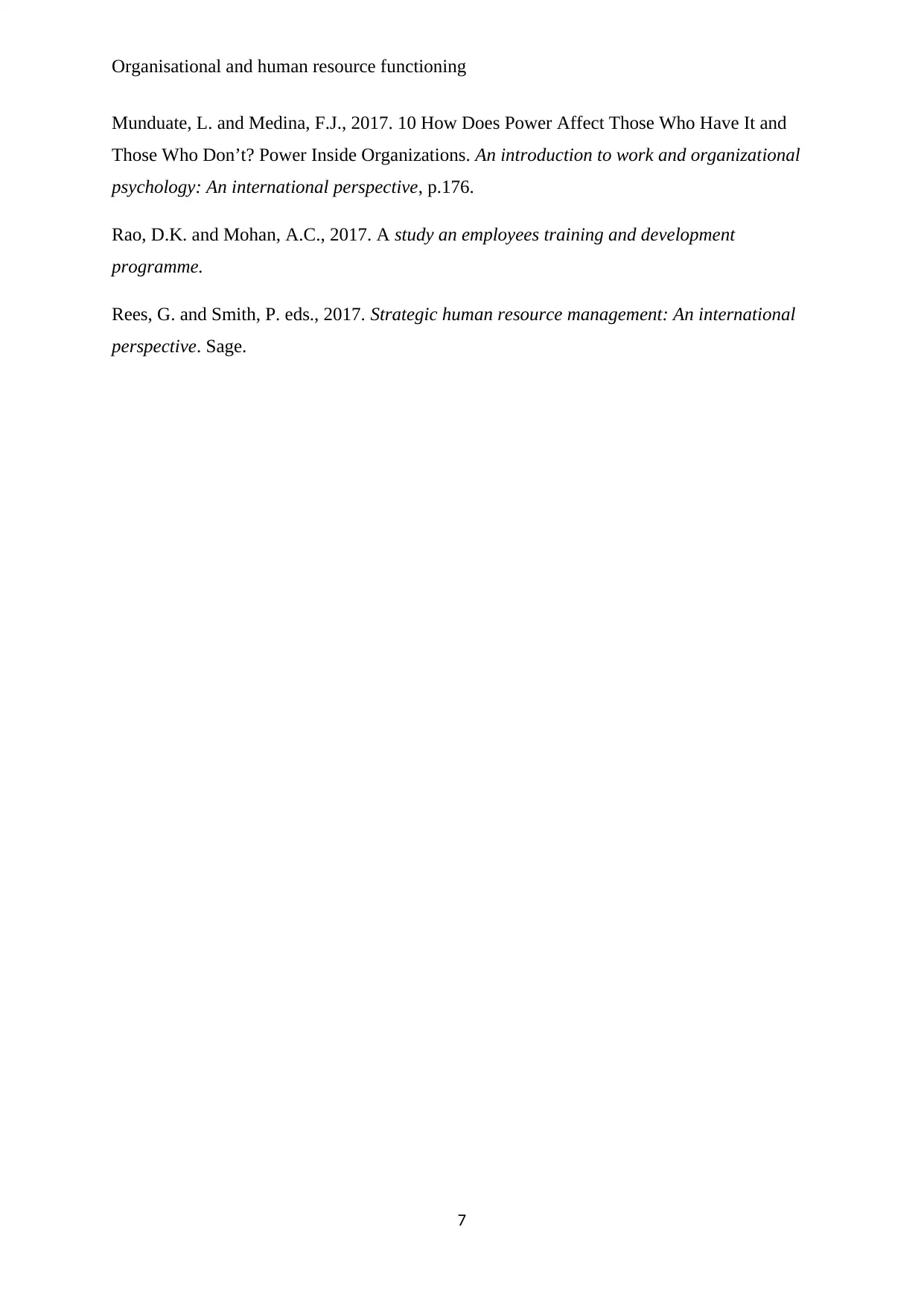
Organisational and human resource functioning
Munduate, L. and Medina, F.J., 2017. 10 How Does Power Affect Those Who Have It and
Those Who Don’t? Power Inside Organizations. An introduction to work and organizational
psychology: An international perspective, p.176.
Rao, D.K. and Mohan, A.C., 2017. A study an employees training and development
programme.
Rees, G. and Smith, P. eds., 2017. Strategic human resource management: An international
perspective. Sage.
7
Munduate, L. and Medina, F.J., 2017. 10 How Does Power Affect Those Who Have It and
Those Who Don’t? Power Inside Organizations. An introduction to work and organizational
psychology: An international perspective, p.176.
Rao, D.K. and Mohan, A.C., 2017. A study an employees training and development
programme.
Rees, G. and Smith, P. eds., 2017. Strategic human resource management: An international
perspective. Sage.
7
1 out of 8
Related Documents
Your All-in-One AI-Powered Toolkit for Academic Success.
+13062052269
info@desklib.com
Available 24*7 on WhatsApp / Email
![[object Object]](/_next/static/media/star-bottom.7253800d.svg)
Unlock your academic potential
Copyright © 2020–2025 A2Z Services. All Rights Reserved. Developed and managed by ZUCOL.





